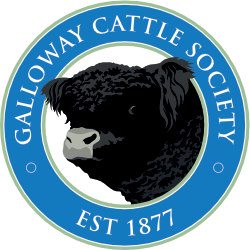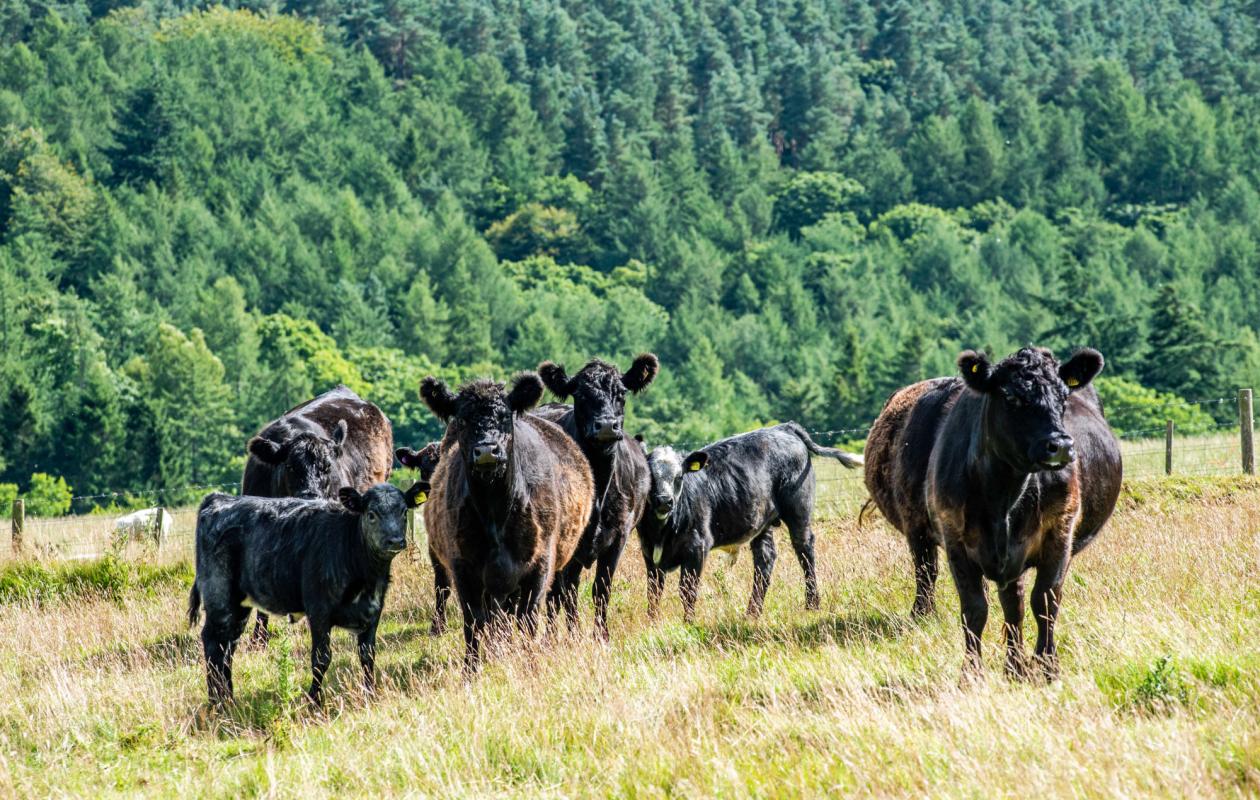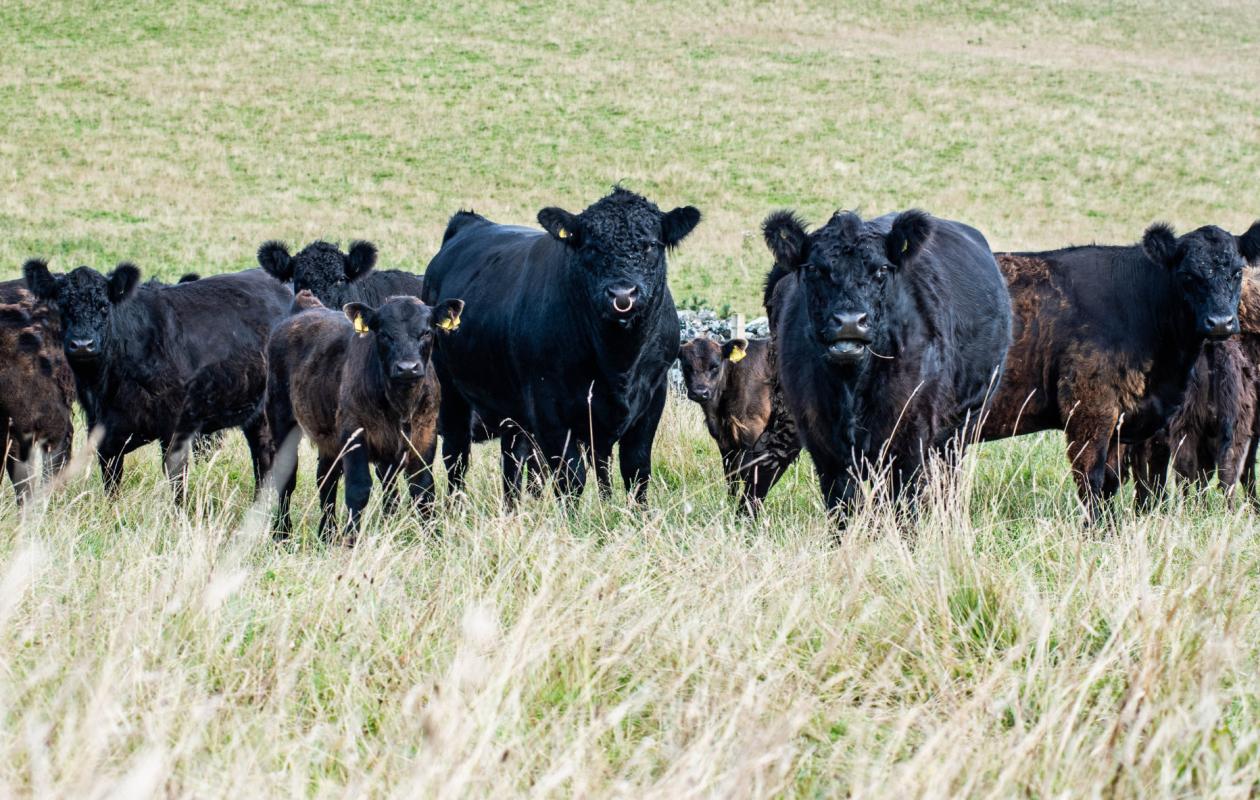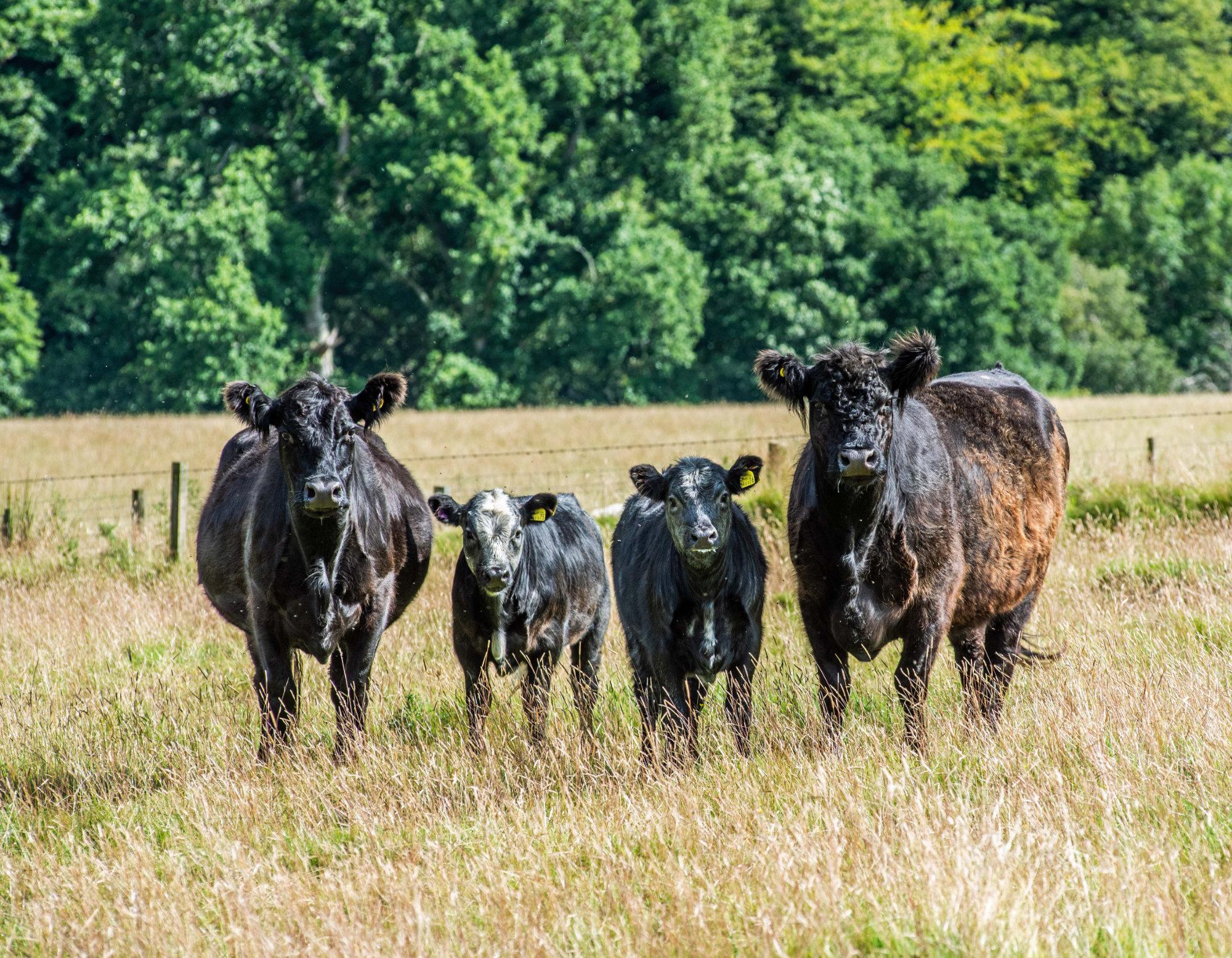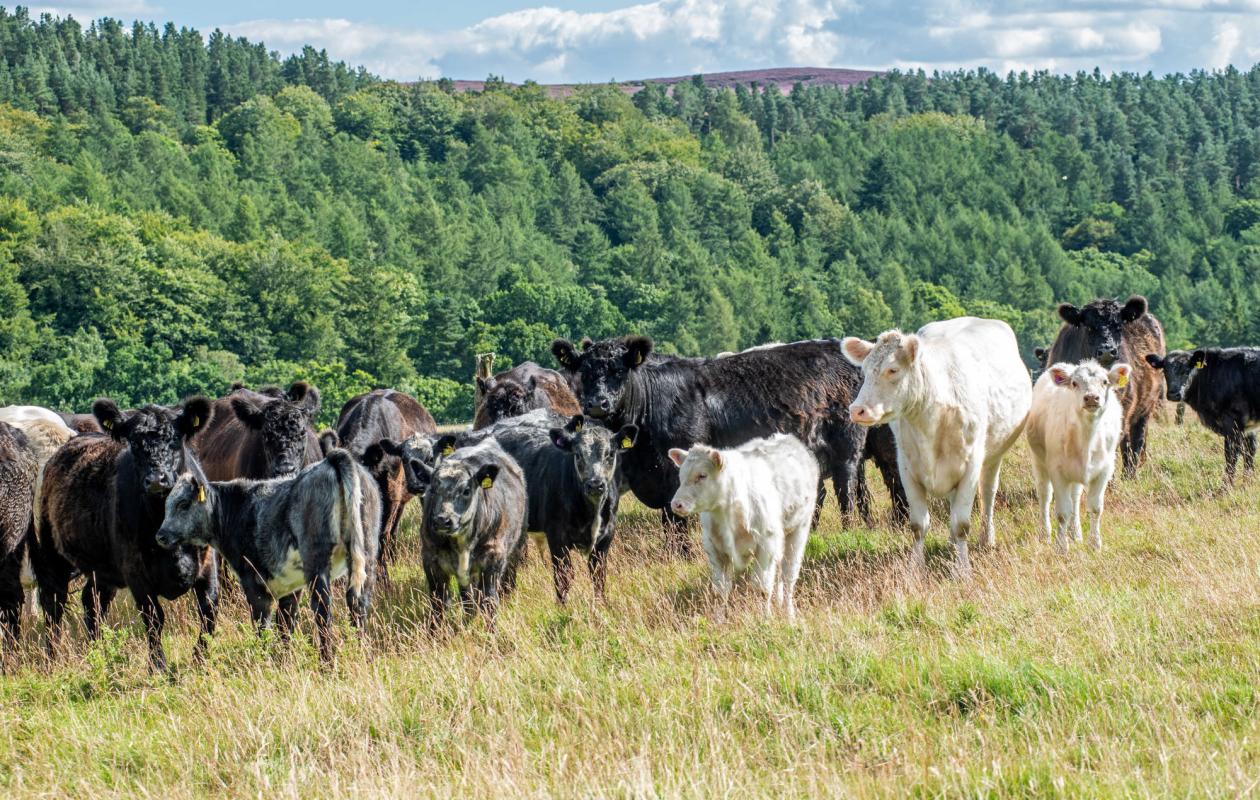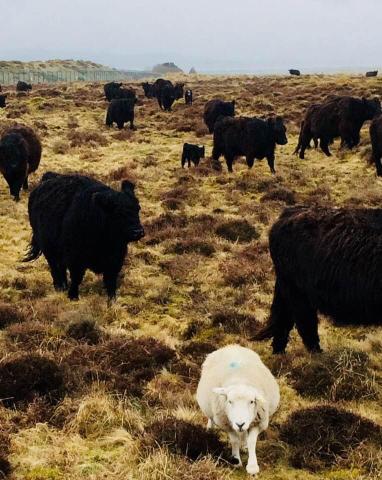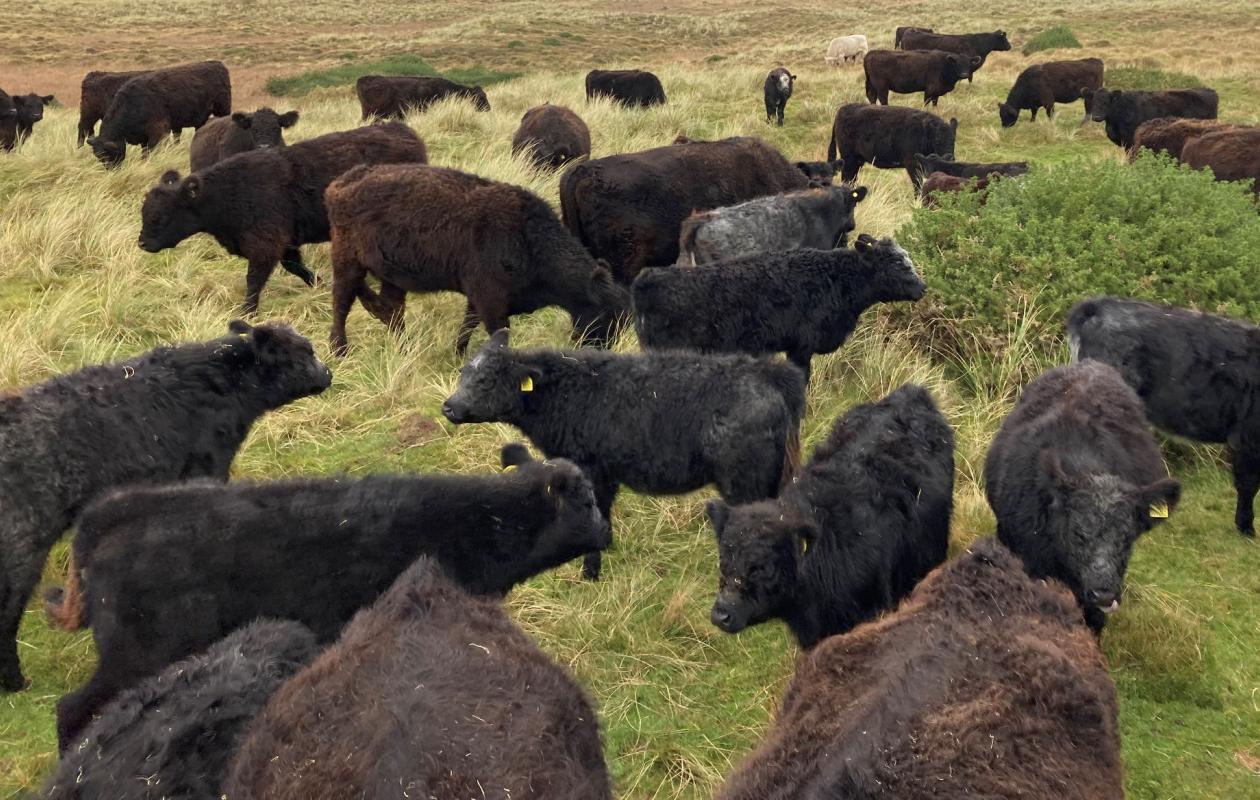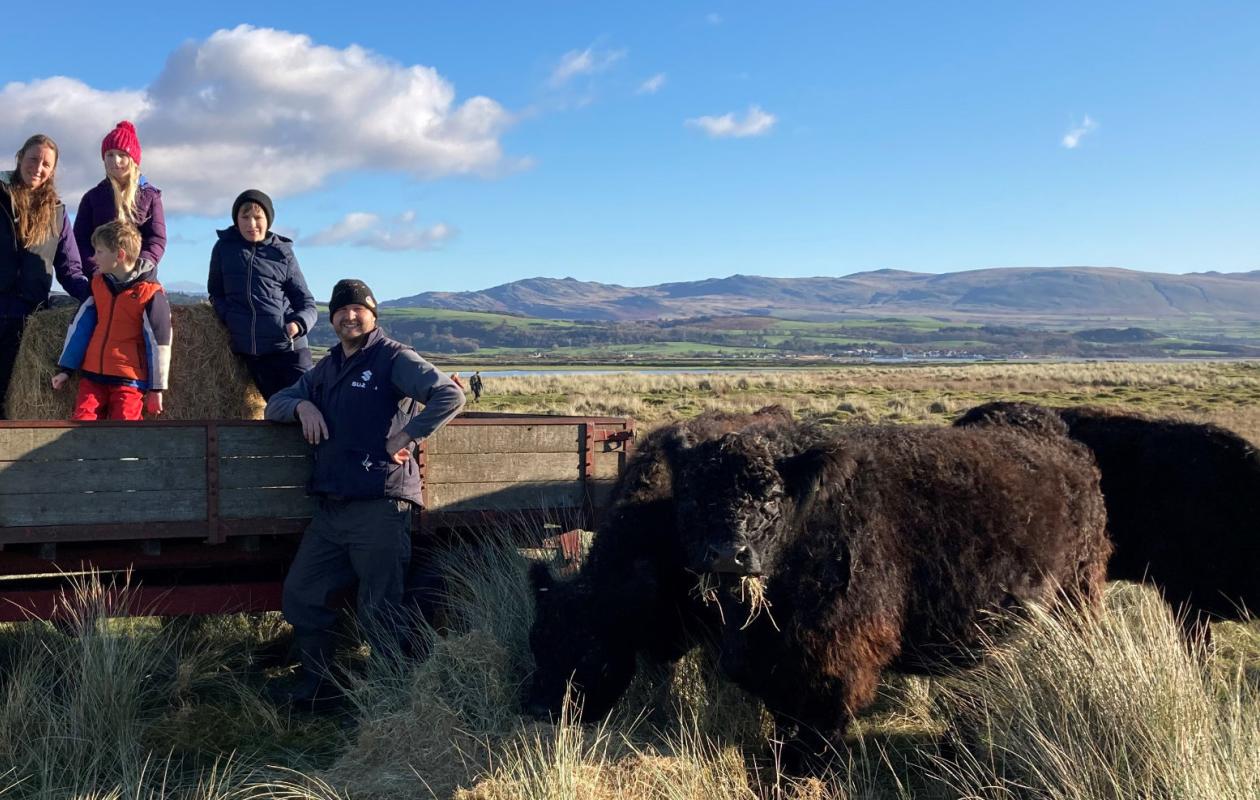Galloway Cattle Society Annual Show and Sale Wallets Marts, Castle Douglas
Show – Thursday 17th February, 2022
Sale – Friday 18th February, 2022
Judge Mr Robert McTurk, Barlaes, Dalry, Castle Douglas.
Trade was a flyer at the Galloway Cattle Society’s two day show and sale held at Wallets Marts, Castle Douglas, with three animals over 10,000gns and a dozen heifers over 5000gns
Selling the lead price of 15000gns for Kirkstead Elite was Society’s Chairman, Alan McClymont, Kirkstead, Yarrow, this much fancied 16 month old is by Troloss Impeccable who was purchased in partnership with David and Rosemarie Cornthwaite, Balgray for 9200gns. Elite was placed 2nd in the show the previous day and is off home with Klondyke Farms Ltd, Shancastle, Moniaive, Thornhill.
10000gns was achieved twice, once for the Male Champion, Unthank Beowulf from Alistair Busby, Unthank, Ewes, Langholm, this March 2020 was the heaviest bull in the mart at 832kgs, is by 3500gns Mandella of Balgray and was purchased by Messrs Spours & Sons, Twizell Farm, Belford, Northumberland for their 70 cow herd.
Ben Lomond Endeavour from J,M & D Maxwell, Blairvockie, Drymen, Glasgow also realized 10,000gns, this May 2020 is a Zonda of Kilnstown son and out of Ben Lomond Waterlily – a Klondyke Raider daughter was sold to Father and Son team, John and Andrew Tullie, Bowanhill, Teviothead, Selkirk. Duncan Maxwell also purchased one of three animals to achieve 8000gns - Barlaes Trooper, from Judge - Robert McTurk, Barlaes, Dalry, Castle Douglas, this 22 month old Troloss Magnum son is out of Barlaes Nancy 126th who is by the homebred sire Barlaes Colossus.
Doug and Jim Ross, Romesbeoch, Shawhead, Dumfries, sold the first bull in the ring - Chopper of Romeseoch also for 8000gns, this October 2019 born, Struthurr Yogi son sold to repeat customer Jimmy Ions, Thornyburn, Falstone, Hexham.
8000gns was the female top price for Brownie 5th of Fingland, from Jimmy Wallace and Family at Fingland, Dalry, Castle Douglas, placed 2nd in its class the day before, this Kirkstead Vindicator daughter who was shared with Kirkstead sold to Mr Steven McKillop, Sallachry East¸ Inveraray. The Fingland Team had a great day in the office, as they sold 6 Kirkstead Vindicator daughters heifers to average 4116gns. Their next best top price of 6500gns was for the first prize heifer Joyce 3rd of Fingland, out of Joyce 1st of Fingland who is the AI sire Orinocho of Over Barskeoch, she went home with R Nixon & E MacPherson, Marbrack, Carsphairn, Castle Douglas. A call of 6000gns was made for the incalf heifer - Brownie 7th of Fingland, this August 2019 heifer is travelling home with Helen Ryman, North Kildarroch, Whauphill, Newton Stewart. Helen also purchased Kathleen 15th of Fingland for 3200gns, Brownie 8th of Fingland - full sister to the top price heifer for 2200gns and Lady Polka 16th of Fingland for 4200gns.
The Female champion was Foxglove Blue of Nether Cleugh from Peter Hunter Blair, Nether Cleugh, Corsock, this September 2019 born Blackcraig Vagabond daughter was sold in calf to Nether Cleugh ‘s new stock bull Klondyke Dominoto and purchased by June and Bobby MacKenzie, Wester Auchnagallen, Grantown of Spey for 7000gns, which is Nether Cleugh best price to date.
The reserve female champion, Blackcraig Blondchen B1089 from John, Ann & Iain Finlay, Blackcraig, Corsock secured 6500gns to Messrs Cowie, Polston Farm, The Mill, Polston. This first place heifer is by the homebred bull Blackcraig Superman and out of Blackcriag Blondchen U 087 who goes back to Blackcraig Sam. This stylish heifer was one of five heifers from the much admired pen from Blackcraig which averaged 3900gns. The next best priced heifer was 5000gns for Blackcraig Shields B1070 is by Nucamp of Balgray and out of Blackcraig Shields and heads north to Stirling with new members 3G Galloways. Another new member J Common & Sons, Crossdykes, Lockerbie purchased another Nucamp of Balgray daughter -Blackcraig Bertha B1045 for 4500gns. Well known German breeder Horst Kraft then secured Blackcraig Moss Rose B1091 for the next best price of 4200gns and Blackcraig Blonchen B1089 sold for 3800gns to G & M Porter, Islay. Blackcraig’s only bull entry – Blackcraig Crofter, a Blackcraig Xtreame son sold for 7000gns sold in a half share deal between Messrs Milligan, Dunesslin, Dunscore, Dumfries and Messrs Wallace, Over Barskeoch, Dalry, Castle Douglas
Averages
19 Bulls £5819.21 (+£1342.02)
22 heifers in calf or ran with bull £3493.63 (-£224)
15 bulling heifers £2506.00 (+£46)
Lot No
Name of animal
DoB
Gns
Purchaser
1
Chopper of Romesbeoch
27/10/2019
8000
J Ions & Son
Hexham
2
Huntly Drummer
26/11/2019
N/F
3
Barlaes Tam O Shanter
30/01/2020
N/F
4
Unthank Beowulf
13/03/2020
10000
SH Spours & Sons
Belford
5
Pegasus of Trolossé
16/03/2020
3000
P G Abel
Petertavy
6
Wareham’s Bullet Tooth Tony
20/03/2020
N/S
7
Wareham’s Corker
22/03/2020
N/F
8
Barlaes Tam
25/03/2020
6000
R Galloway
Stirling
9
Barlaes Trooper
31/03/2020
8000
J, M & D Maxwell
Blairvockie
10
Withdrawn
11
Barlaes Toledo
06/04/2020
5500
Cnewr Estate
Sennybridge
12
Dare Devil of Over Barskeoch
14/04/2020
N/S
13
Wareham’s Unstopabull
17/04/2020
N/S
14
Raider of Balgray
21/04/2020
N/S
15
Withdrawn
16
Dominator of Romesbeoch
01/05/2020
4500
D Lewis
Llanwrda
17
Rebellious of Balgray
03/05/2020
N/F
18
Ben Lomond Endeavour
04/05/2020
10000
J Tullie
Bowanhill
19
Ring Leader of Balgray
09/05/2020
1800
MacMillan & Partners
Castle Douglas
20
Pioneer of Trolossé
24/05/2020
6000
T Byers
Wigton
21
Dava Dave
21/06/2020
N/S
22
Warhorse of Fingland
22/07/2020
N/F
23
Commander of Kilnstown
05/09/2020
3000
J Steele
Lanark
24
Century of Kilnstown
07/09/2020
N/S
25
Conquer of Kilnstown
08/09/2020
N/F
26
Kirkstead Eliminator
13/09/2020
2000
DW Gourlay & Co
Craigmuie
27
Dava Duke
14/09/2020
N/F
28
Blackcraig Crofter
21/09/2020
7000
Milligan & Wallace
Dunesslin & Over Barskeoch
29
Blackcraig Clansman
23/09/2020
N/F
30
Kirkstead Elite
28/09/2020
15000
Klondyke Farms Ltd
Shancastle
31
Conundrum of Nether Cleugh
05/10/2020
2500
H Kraft
Germany
32
Barquhill Hector
14/10/2020
3000
W Wallace & Sons
Fingland
33
Explosion of Over Barskeoch
11/11/2020
N/S
34
Rhodium of Balgray
17/11/2020
2500
G Roarty
N Ireland
35
Kirkstead Expert
03/03/2021
6500
D & R Cornthwaite
Balgray
36
Creditor of Kilnstown
06/04/2021
N/F
37
Jess 371 of Troloss
13/03/2019
4000
D Henry
Ballymena
38
Brownie 5th of Fingland (Twin)
26/04/2019
8000
S McKillop
Inveraray
39
Brownie 7th of Fingland
01/08/2019
6000
H Ryman
Whauphill
40
Penelope of Balgray (ET)
04/09/2019
N/S
41
Foxglove Belle of Nether Cleugh (Twin)
12/09/2019
1800
R Nixon
Marbrack, Castle Douglas
42
Foxglove Blue of Nether Cleugh (Twin)
12/09/2019
7000
J MacKenzie
Grantown
43
Blackcraig Bertha B1045
23/09/2019
4500
J Common & Son
Crossdykes, Lockerbie
44
Countess Balalika of Nether Cleugh
07/10/2019
N/F
45
Blackcraig Shields B1070
14/10/2019
5000
3 G - Galloway
Stirling
46
Barquhill Almond 1088
28/10/2019
N/S
47
Blackcraig Blondchen B1089
07/11/2019
6500
J Cowie
Polston
48
Blackcraig Blondchen B1088
07/11/2019
3800
G & M Porter
Islay
49
Blackcraig Moss Rose B1091
11/11/2019
4200
HH Kraft
Germany
50
Barquhill K Blondchen 1091
16/11/2019
3200
J Campbell
Strathaven
51
Barquhill Moss Rose 1096
18/11/2019
1800
SL McCarthy
Borgue
52
Joyce 3rd of Fingland
16/03/2020
6500
R Nixon
53
Klondyke Page
21/03/2020
N/S
Marbrack, Castle Douglas
54
Kathleen 15th of Fingland
05/04/2020
3200
H Ryman
Whauphill
55
Brownie 8th of Fingland
07/04/2020
2200
H Ryman
Whauphill
56
Lady Polka 16th of Fingland
25/04/2020
4200
H Ryman
Whauphill
57
Beauty 2316 of Romesbeoch
25/04/2020
2500
J Heard
Hughslade, Okehampton
58
Daisy 2317 of Romesbeoch
25/04/2020
N/F
59
Lady Diana 2319 of Romesbeoch
28/04/2020
2100
G & M Porter
Islay
60
Beauty 2320 of Romesbeoch
29/04/2020
N/S
61
Anusha 2325 of Romesbeoch
04/05/2020
2800
J Heard
HuGhslade, Okehampton
62
Kirkstead Nerys Ingrid D2
15/09/2019
1600
D & C Logan
Stirling
63
Kirkstead Nerys Ingrid D6
21/09/2019
1300
J Steele
Lanark
64
Kirkstead Quirk D9
27/09/2019
N/F
65
Kirkstead Quirk D16
12/10/2019
2500
J McCurdy
Broughshane
66
Kirkstead Lea D13
30/09/2019
3000
B Douglas
Castlederg
67
Kirkstead Quirk D17
20/10/2019
1600
D Henry
Ballymena
68
Kirkstead Quirk D19
02/11/2019
0
69
Kirkstead Nancy D21
12/11/2019
1200
J Steele
Lanark
70
Kirkstead Quirk D23
25/12/2019
N/F
71
Kirkstead Amber D24
29/01/2020
1800
R Nixon
Marbrack, Castle Douglas
72
Klondyke Olympia
18/09/2019
N/S
73
Klondyke Orchard
19/09/2019
N/S
74
Klondyke Oven
11/10/2019
N/S
75
Klondyke Orrel
23/10/2019
N/F
76
Barlaes Nancy 181st
02/04/2020
N/S
77
Barlaes Katie 96th
04/04/2020
1700
D McClintock
Broughshane
78
Barleas Katie 97th
07/04/2020
1200
B Douglas
Castlederg
79
Barlaes Black Ice 7th
15/04/2020
2500
R Galloway
Stirling
80
Roustabout of Balgray
03/05/2020
1800
J Common & Son
Crossdykes, Lockerbie
81
Ribena of Balgray
03/05/2020
1400
D McClintock
Broughshane
82
Reunion of Balgray
05/05/2020
1400
J McCurdy
Broughshane
83
Randy of Balgray
18/05/2020
N/F
84
Raven of Balgray
21/05/2020
1600
J McCurdy
Broughshane
